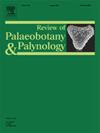末次冰期-间冰期过渡与全新世早期植被重建:49°S亚南极森林序列的花粉和植物大化石分析。
IF 1.7
3区 地球科学
Q2 PALEONTOLOGY
引用次数: 0
摘要
了解植物群落演替;本文对南巴塔哥尼亚冰原东部地区进行了从末次冰期-间冰期过渡到全新世早期(18500 ~ 9000 cal yr BP)的古环境重建,以期为该地区提供区域知识基础。本研究基于Mallín cipracimys湿地(49°S;南圣克鲁斯,巴塔哥尼亚,阿根廷)。在18500 - 16000 cal yr BP之间,研究区普遍处于寒冷和干旱的气候条件下,以麻黄属植物为主的矮灌木群落可能受到减弱的西南风(SWW)的影响。从16000到12800 cal yr BP,随着水分的增加和Nothofagus的扩张,向草矮灌木草原的转变发生了,这可能是由与南极冷逆转同时发生的更强的西南偏南驱动的。在12800 - 9600 cal yr BP之间,我们观察到西部草原与Nothofagus森林扩张,表明在较弱的西风下,气候温暖但相对干旱。早在距今10500万年,毛毛蕨就开始形成,标志着湿地现代动态的开始。在9600 calyr BP之后,Nothofagus林的显著扩张反映了全新世早期变暖期间湿度的增加。这项研究填补了SPIF东部古生态知识的一个关键空白,为48°至52°S之间SWW变率、温度波动和冰川动力学对植被发育的影响提供了见解。本文章由计算机程序翻译,如有差异,请以英文原文为准。
Last glacial–interglacial transition and early Holocene vegetation reconstruction: Pollen and plant macrofossil analysis from a Subantarctic forest sequence at 49°S.
To understand plant community succession; paleoenvironmental history, and to contribute to the regional knowledge base for the eastern area of the Southern Patagonian Icefield (SPIF), we present a paleoenvironmental reconstruction from the last glacial–interglacial transition to the early Holocene (18,500 to 9000 cal yr BP). This research was based on pollen and plant macrofossil analyses together with lithostratigraphy characterization from a sequence obtained at the Mallín Ciprés wetland (49°S; Southern Santa Cruz, Patagonia, Argentina). Between 18,500 and 16,000 cal yr BP, cold and arid conditions prevailed in the study area with dwarf-shrub communities dominated by Ephedra, likely under weakened Southern Westerly Winds (SWW). From 16,000 to 12,800 cal yr BP, a shift to grass-dwarf-shrub steppes occurred, along with increased moisture and expansion of Nothofagus, likely driven by stronger SWW contemporaneous with the Antarctic Cold Reversal. Between 12,800 and 9600 cal yr BP, we observe a western grass steppe with Nothofagus forest expansion, indicating warmer but relatively arid conditions under weaker westerly winds. Pilgerodendron began to establish at 10,500 cal yr BP, marking the onset of the wetland's modern dynamics. After 9600 cal yr BP, the significant spread of Nothofagus forest reflects increased moisture during early Holocene warming. This study addresses a critical gap in paleoecological knowledge of the eastern SPIF, providing insights into the influence of SWW variability, temperature fluctuations, and glacial dynamics on vegetation development between 48° and 52°S.
求助全文
通过发布文献求助,成功后即可免费获取论文全文。
去求助
来源期刊
CiteScore
3.50
自引率
21.10%
发文量
149
审稿时长
6 months
期刊介绍:
The Review of Palaeobotany and Palynology is an international journal for articles in all fields of palaeobotany and palynology dealing with all groups, ranging from marine palynomorphs to higher land plants. Original contributions and comprehensive review papers should appeal to an international audience. Typical topics include but are not restricted to systematics, evolution, palaeobiology, palaeoecology, biostratigraphy, biochronology, palaeoclimatology, paleogeography, taphonomy, palaeoenvironmental reconstructions, vegetation history, and practical applications of palaeobotany and palynology, e.g. in coal and petroleum geology and archaeology. The journal especially encourages the publication of articles in which palaeobotany and palynology are applied for solving fundamental geological and biological problems as well as innovative and interdisciplinary approaches.

 求助内容:
求助内容: 应助结果提醒方式:
应助结果提醒方式:


